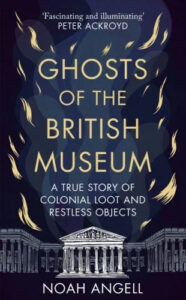Book Review: Ghosts of the British Museum
It is perhaps not surprising to discover that the British Museum, founded in the eighteenth century at the former mansion of the Duke of Montagu, has more than its fair share of ghosts.
In Ghosts of the British Museum: A True Story of Colonial Loot and Restless Objects (Monoray, 2024. H/bk, xxii+232 pages) Noah Angell draws on the experiences of former Museum staff, psychics, occultists, and other informants to draw out tales of strange presences, apparations on CCTV and cameras, doors that open of their own accord, and much more. Angell spent seven years interviewing Museum staffers, particularly the cleaners, security guards, and janitors who pace the seemingly endless corridors of the Museum at night. He paints a picture of the Museum as a hulking iceberg-like structure; with vast underground basements stuffed with forgotten artefacts. There is a shooting gallery and an air-raid shelter down there; the river Fleet flows through pipes through it. Angell explores a persistent rumour that there is an entire Ethiopian monastery within the storage basement. Some of Angell’s informants subscribe to a ‘Stone Tape’ explanation (named for Nigel Kneale’s classic 1972 drama); that buildings and objects can absorb and release memories of events that have occurred within and around them.
But Ghosts of the British Museum is more than just a comfortable collection of spooky stories; it is a fierce critique of our colonial past and how the Museum is a monument to the maintenance of that uncomfortable legacy; the all-too convenient forgetting of how Britain became “Great”. Angell describes the British Museum as a “black hole” … “a colonial-era experiment that has outstayed its time”. One of the most famous (or notorious) examples of colonial loot at the Museum is the Benin Bronzes. Following an assault on Benin in 1897, the British seized over a thousand bronze art pieces from the royal palace of the Kingdom of Benin (now Southern Nigeria). Some Europeans refused to believe that these artworks could not have been created by Africans, and had been made by Portuguese sailors passing through the kingdom. Angell explains that the artworks were made to commemorate key events in the life of the kingdom, forming an “embodiment of its continuity” rather than mere “native curiosities” as they were described by British Museum curator Charles H. Read. Nigeria has been requesting that the Museum return the bronzes since gaining independence from Britain in 1960, but so far, without result. In 2022, the Horniman Museum began the process of handing back the 72 Benin bronzes from its own collection, with a ceremony attended by Abba Tijani, director general of Nigeria’s National Commission for Museums and Monuments.
The British Museum has suffered repeated scandals of late. In June 2023, Yilin Wang, a translator, poet and editor accused the Museum of plagiarising her translations of the Chinese revolutionary, Qiu Jin (1875 – 1907), using them in an exhibition and catalogue for the museum’s “China’s Hidden Century” exhibition. Yilin Wang stated that she was not contacted for permission or received any credit or payment for her translations. Then in August 2023 it was revealed that nearly 2,000 artefacts were missing from its collection, and were believed to have been stolen by a senior curator. This event tends to undermine the long-argued assertion that appropriated artefacts are ‘safer’ if the Museum holds onto them. Another argument is that the Museum cannot return items to their original owners due to legislation (British Museum Act 1963). In 2009, the Holocaust (Return of Cultural Objects) Act empowered Museums to return “certain cultural objects on grounds relating to events occurring during the Nazi era” its scope was very limited, and thus far, despite several attempts to amend the existing legislation, nothing has changed.
Another theme throughout Ghosts of the British Museum is the agency that we afford to objects, or even that objects have their own agency. This is most evident in Angell’s explorations of how Museum visitors relate to the artefacts on display, such as the people who leave regular offerings to the statues of Sekhmet. It is an issue Angell returns to time and time again, imagining, for example, how the stored human remains languishing in the stygian depths of the Museum’s storage basements might feel about their enforced captivity.
All in all, Ghosts of the British Museum is a fascinating and engaging book, with a fund of puzzling stories of ghosts and strange encounters, yet at the same time posing serious questions about how we relate to the sacred, restless spirits, and the ghosts of the colonial past (and present). Two other titles dealing with the issues Angell explores I’d recommend are Geoffrey Robertson’s Who Owns History?: Elgin’s Loot and the Case for Returning Plundered Treasure (Biteback Publishing, 2019) and Sacred Objects in Secular Spaces: Exhibiting Asian Religions in Museums, edited by Bruce M. Sullivan (Bloomsbury Academic, 2015).
Links of interest:
Interview with Noah Angell
Coloniality and the British Museums
The Stone Tape on youtube

